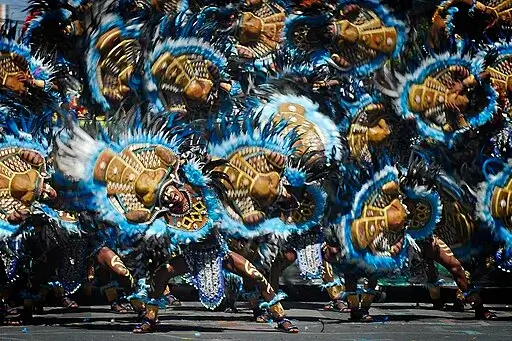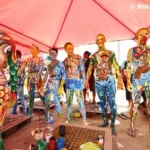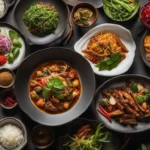Image Source: Wikimedia Commons
The Dinagyang Festival in Iloilo City is the perfect opportunity to experience the rich traditions and history of the Ati Tribe and the Visayan Festivals.
This electrifying event boasts a lineup of exhilarating Iloilo Events, from the energetic performances of the Dinagyang Warriors to the Religious Pageantry of the Santo Niño Procession.
The rhythmic Drum Beats and colorful Festival Costumes will leave you in awe, while the Tribal Performances will transport you back in time to explore the fascinating Philippine History.
Don’t miss out on this incredible cultural celebration in the heart of the Philippines!
Key Takeaways:
- Ati Tribe: The Dinagyang Festival in Iloilo City celebrates the Ati Tribe, the indigenous people of the Philippines. Their vibrant cultural heritage is showcased through various tribal performances and festival costumes.
- Visayan Festivals: The Dinagyang Festival is one of the most famous Visayan festivals in the Philippines, known for its religious pageantry and drum beats. It is a significant event that reflects the rich cultural history of the Visayan region.
- Santo Niño Procession: The festival’s highlight is the Santo Niño procession, where Dinagyang warriors pay homage to the Child Jesus. This religious aspect underscores the deep connection between the festival and Philippine history.
Facts About the Dinagyang Festival Philippines
| Facts | Explanation |
|---|---|
| Festival Name | Dinagyang Festival |
| Brief History of the Festival | – The Dinagyang Festival is a religious and cultural festival held in Iloilo City, Philippines. It is celebrated every fourth Sunday of January to honor the Santo Niño (Child Jesus). – The festival originated in 1967 when a replica of the Santo Niño was brought to Iloilo from Cebu City. The festival was created as a response to the Ati-Atihan Festival in Kalibo, Aklan, and has since become one of the biggest and most colorful festivals in the Philippines. |
| Location of the Festival | The Dinagyang Festival takes place in Iloilo City, which is located on the island of Panay in the Western Visayas region of the Philippines. |
| Brief History of Iloilo City | – Iloilo City is a highly urbanized city in the Western Visayas region. It is known as the “Heart of the Philippines” due to its central location in the country. The city has a rich history and was once a major trading port during the Spanish colonial period. – Iloilo City is also known for its beautiful churches and ancestral houses, showcasing its colonial past. It has become a center for education, commerce, and tourism in the region. |
| Ethnic Information | The Dinagyang Festival incorporates elements of the Ati tribe, an indigenous group that originally inhabited Panay Island. The festival pays homage to the Ati people and their customs through dance and music performances. |
| Main Events and Activities | – Ati-Atihan Street Dancing Competition: This is the highlight of the festival, where various tribes clad in vibrant costumes perform traditional dances in the streets of Iloilo City. – Kasadyahan Cultural Competition: A showcase of different cultural presentations highlighting the history and traditions of Iloilo City and its neighboring provinces. – Religious Procession: A solemn procession featuring the Santo Niño image is held during the festival, attracting devotees and tourists alike. – Float Parade: Colorful floats adorned with intricate designs and decorations parade through the city streets. – Dinagyang Food Festival: A culinary event that offers a wide array of local delicacies and traditional dishes. |
| Related Festivals in the Region | – Ati-Atihan Festival (Kalibo, Aklan): Known as the “Mother of all Philippine Festivals,” this festival also honors the Santo Niño through lively street dancing and indigenous rituals. The Dinagyang Festival draws inspiration from the Ati-Atihan Festival. – Pintados Festival (Tacloban City, Leyte): This festival showcases the rich cultural heritage of Leyte through body painting and street dancing. – Sinulog Festival (Cebu City): Another popular festival in the Philippines, the Sinulog Festival celebrates the Santo Niño with colorful parades, street dancing, and religious processions. |
Historical Context
To truly appreciate the Dinagyang Festival, you need to understand its historical context. This colorful and vibrant celebration is deeply rooted in the rich history of the Ati tribe, the Visayan festivals, and the Iloilo events.
Origins of the Ati Tribe
According to historians, the Ati tribe were the first settlers in the Philippines, making them the original inhabitants of the islands.
They were known as skilled hunters and gatherers, living harmoniously with nature. Unfortunately, their peaceful way of life was disrupted when the Malay settlers arrived, which led to centuries of marginalization and discrimination.
Despite the challenges they faced, the Ati tribe managed to maintain their unique cultural traditions, including their distinctive language, music, and dance.
Historical Significance of Dinagyang Festival in Iloilo City, Philippines
The Dinagyang Festival in Iloilo City, Philippines, is celebrated to honor the Santo Niño (Holy Child or Infant Jesus) and commemorate the pact between the Datus and the locals after the arrival of Malay settlers on Panay Island.
The festival’s roots can be traced back to the introduction of the devotion to Santo Niño in 1967 by Rev. Fr. Ambrosio Galindez, and it has since evolved into one of the largest and most acclaimed festivals in the country.
The festival’s historical significance lies in its role as a celebration of cultural heritage, religious devotion, and the enduring legacy of the Santo Niño.
Evolution of Dinagyang and Philippine History
The evolution of the Dinagyang Festival is closely intertwined with the complex tapestry of Philippine history. The festival itself was born out of a blend of two significant events, the arrival of Malay settlers and the introduction of Christianity by Spanish missionaries.
History also saw the Ati tribe being pushed to the margins of society, but the Dinagyang Festival provides an opportunity for these marginalized people to celebrate their cultural heritage with pride and joy.
Through the festival, the Ati tribe showcases their resilience and their determination to keep their traditions alive.
Cultural Elements
Some of the most captivating cultural elements of the Dinagyang Festival include the vibrant performances of the Ati Tribe, the pulsating drum beats, and the intricate festival costumes that represent the rich history and traditions of the Visayan people.
The festival is a celebration of the pre-colonial heritage of the indigenous Ati people, as well as the arrival of Malay settlers who brought the image of Santo Niño to the shores of Iloilo.
Religious Pageantry and the Santo Niño Procession
The religious pageantry of the Dinagyang Festival is a spectacle to behold. As part of the festivities, devotees participate in the Santo Niño Procession, where the image of the Holy Child Jesus is paraded through the streets amidst colorful decorations and fervent prayers.
The procession is a deeply spiritual experience, as it symbolizes the profound faith and devotion of the Ilonggos to Santo Niño, their patron saint.
Significance of the Dinagyang Warriors
The Dinagyang Warriors play a pivotal role in the festival, embodying the strength, agility, and fearlessness of the Ati warriors who once roamed the plains of Panay.
These skilled performers capture the essence of Ati’s bravery and resilience, mesmerizing the audience with their powerful dance moves and daring stunts.
Their performances are a testament to the indomitable spirit of the Ati people, reminding you of the paramount significance of their legacy in Philippine history.
Tribes Winner Information
| Year | Tribe | Barangay / Company / School |
|---|---|---|
| 1970 | Madjapahit Tribe of Compania Maritima | Compania Maritima |
| 1971 | Mamau Tribe of Negros Navigation | Negros Navigation |
| 1972 | Mamau Tribe | Negros Navigation |
| 1973 | Mamau Tribe | Negros Navigation |
| 1974 | Last Warriors | Panaderia de Molo |
| 1975 | Tribu Hamili | Barangay General Hughes, Iloilo City Proper |
| 1976 | Tribu Hamili | Barangay General Hughes, Iloilo City Proper |
| 1977 | Contest Not Held | – |
| 1978 | Tribu Atub-atub | Barangay Veteran’s Village, Iloilo City Proper |
| 2022 | Tribu Lapaz – Paghirupay (Closeness) | La Paz District, Iloilo City |
| 2023 | Tribu Parianon | Molo District, Iloilo City |
Festivity Highlights
Now, let’s take a closer look at the highlights of the Dinagyang Festival that make it one of the most anticipated events in the Philippines.
From the vibrant festival costumes to the rhythmic drum beats and tribal performances, there are so many reasons why you should experience this celebration at least once in your lifetime.
The vibrancy of the Festival Costumes
When you attend the Dinagyang Festival, you’ll be amazed by the vibrant and colorful festival costumes worn by the performers.
The intricate designs and detailed embellishments of the costumes bring the history and culture of the Ati tribe to life.
The use of bright colors and traditional patterns creates a visually stunning display that truly captures the spirit of the festival. You won’t be able to take your eyes off the stunning attire of the participants as they parade through the streets.
Rhythm of the Drum Beats and Tribal Performances
As you immerse yourself in the festivities, you’ll feel the electric energy of the drum beats and tribal performances that fill the air.
- The rhythmic drumming creates an atmosphere of excitement and anticipation, drawing you in and making you want to dance along.
- The skilled dancers and performers showcase traditional Ati tribe movements and cultural expressions, captivating you with their dynamic and powerful performances.
- The combination of the pulsating drum beats and the mesmerizing tribal dances will leave you with a deep appreciation for the rich heritage of the Philippines.
Dinagyang’s Place in Visayan Festivals
To understand the significance of the Dinagyang Festival, it is important to consider its place among the many lively and colorful festivals that take place in the Visayan region of the Philippines.
As one of the most popular and widely attended festivals in the country, Dinagyang holds a special place in the hearts of the people of Iloilo City and the Visayan community as a whole.
The festival’s unique blend of religious pageantry, vibrant performances, and rich cultural traditions sets it apart and makes it a must-see event for locals and visitors alike.
Comparison with Other Visayan Events
When comparing Dinagyang with other Visayan festivals, it is important to note that each event has its unique character and significance.
While Sinulog in Cebu City and Ati-Atihan in Aklan are also popular festivals that celebrate the Santo Niño, Dinagyang stands out for its dynamic and high-energy performances by the Ati Tribe, known as Dinagyang Warriors.
The festival’s elaborate costumes and pulsating drumming create a truly electrifying atmosphere that sets it apart from other Visayan events.
Impact on Regional Identity and Tourism
The Dinagyang Festival has had a significant impact on the regional identity of Iloilo City and the surrounding areas. This event has become a source of immense pride for the local community, showcasing the region’s rich cultural heritage and traditions.
Additionally, the festival has greatly contributed to the growth of tourism in the area, attracting thousands of visitors from all over the world who come to witness the spectacle of Dinagyang.
Its positive impact on the local economy and promotion of cultural tourism cannot be overstated.
Summary of
| Category | Information |
|---|---|
| Name | Dinagyang Festival |
| Also called | Dinagyang |
| Observed by | Iloilo City |
| Type | Religious / Cultural |
| Date | Fourth Sunday in January |
| 2022 date | January 23 |
| 2023 date | January 22 |
| 2024 date | January 28 |
| 2025 date | January 26 |
| Origin | Iloilo City, Philippines |
| Significance | Celebration of Santo Niño and local pact |
| Etymology | Celebration of Santo Niño and Local Pact |
| History | Introduced by Rev. Fr. Ambrosio Galindez in 1967, ordered as a tourism event by the Marcos government in 1977 |
| Recognition | Ati Tribe Competition, Dagyang sa Calle Real, Miss Iloilo Dinagyang, Kasadyahan Cultural competition (before 2020) |
| Main Events | Ati Tribe Competition, Dagyang sa Calle Real, Miss Iloilo Dinagyang, Kasadyahan Cultural competition (prior to 2020) |
| Notable Features | Ati Tribe competition with “warrior” dancers, Hala bira catchphrase, carousel performance, mobile risers, Dinagyang pipes, Dagoy mascot |
What Are the Main Differences Between Dinengdeng Festival and Dinagyang Festival in the Philippines?
The dinengdeng festival celebration and the Dinagyang festival in the Philippines showcase distinct cultural traditions. While both are celebrated in the same country, they differ in terms of location, activities, and origins. Dinengdeng festival celebration honors the region’s indigenous cuisine, featuring savory vegetable dishes. On the other hand, Dinagyang festival showcases the rich cultural heritage of Iloilo City, featuring vibrant street performances and a grand parade. These festivities offer unique experiences that highlight the diverse cultures within the Philippines.
Conclusion
From above, you can see that the Dinagyang Festival in Iloilo City is a vibrant and culturally rich celebration that showcases the traditions and history of the Ati Tribe and the Santo Niño.
The festival’s energetic drum beats, colorful costumes, and tribal performances create a lively and immersive experience for visitors. As one of the most anticipated Visayan festivals, the Dinagyang Festival is a testament to the resilience and spirit of the Filipino people.
Whether you are a history enthusiast, a lover of religious pageantry, or simply someone looking to immerse yourself in the beauty of Philippine culture, this festival is a must-see event that will leave you captivated and inspired.
Do not miss the opportunity to witness the Dinagyang Warriors, experience the Santo Niño procession, and celebrate the rich heritage of Iloilo City.



